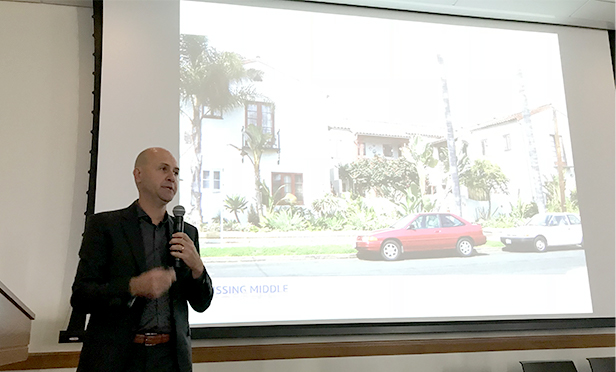 Daniel Parolek of Berkeley, CA-based Opticos Design, discusses the “Missing Middle” of housing at Drexel University, October 12, 2018 (Steve Lubetkin Photo/StateBroadcastNews.com)
Daniel Parolek of Berkeley, CA-based Opticos Design, discusses the “Missing Middle” of housing at Drexel University, October 12, 2018 (Steve Lubetkin Photo/StateBroadcastNews.com)
Update: An audio report has been added to this news story. See below.
PHILADELPHIA, PA—Increasing the availability of “missing middle” housing in urban environments like Philadelphia means recognizing changing household demographics and changing the way developers discuss multifamily projects with zoning and planning officials, and with residents of traditionally single-family areas where more housing is needed, says Daniel Parolek of Berkeley, CA-based Opticos Design.
Parolek was the keynote speaker for the Delaware Valley Smart Growth Alliance's program on “The Missing Middle: Meeting the Housing Demand in Walkable Urban Places,” at Drexel University's LeBow Business School October 12.
The “missing middle” encompasses the housing types that are not being built along the spectrum from single-family homes to multi-story apartments and condominiums, Parolek says. It includes such designs as duplexes, fourplexes, cottage courts and mansion apartments, he says.
You can hear an audio news report on the Delaware Valley Smart Growth Alliance program about Missing Middle Housing in the player below.
“It's a range of housing types that are house-scale, that is very compatible with a house, but they happen to have multiple units inside of it,” Parolek tells GlobeSt.com. “Missing middle housing types have existed exist in every pre-1940s neighborhood, especially in a place here like Philadelphia, where these have really historically been a core of the DNA for a lot of the neighborhoods and smaller towns as well.”
 Missing middle housing types include duplexes, quadplexes, cottage courts and town homes (Source: MissingMiddleHousing.com)
Missing middle housing types include duplexes, quadplexes, cottage courts and town homes (Source: MissingMiddleHousing.com)Gaining community support for a broad increase in missing middle housing means developers and architects need to be able to discuss this kind of housing with government officials and others more effectively.
“It gets the conversation about housing choice away from those very loaded terms that we like to use as planners and architects and even builders, of 'density,'” Parolek says. Communities ought to be able to change the conversation to focus on the form and scale of the buildings rather than the density, he says.
“It shouldn't matter if this beautiful two story C-shaped apartment building has four two-bedroom or eight one-bedroom apartments in it,” he says, showing an image of an existing apartment court being redeveloped.
Changing demographics will demand changes in the way missing middle housing is approached, Parolek says.
“Over the course of the last 20 years, there has been a dramatic shift in household demographics and every time we present these it shocks me a little bit,” he says. “This idea of this 1950s nuclear family that so many communities and the development community created in in these planning documents and have still latched onto, really doesn't exist. There's very, very little of it and it's becoming a smaller and much smaller percentage of the population.”
Thirty percent of the households in most markets are single-person households, Parolek says. “This market's not being met in almost any city across the country,” he says.
By 2025, according to census data, 75-85% of households will not have children, he says. And by 2030, one in five Americans will be over 65.
“So once again this conversation that a lot of communities are having is that we need to be building housing for families, yeah, that's important, but we need to acknowledge the fact that only 25 percent of the households actually have children so we need to serve that other 75 percent of the population as well,” he says.
Parolek showed an audience of about 100 planners, developers, and other real estate industry professionals examples of multifamily redevelopments of existing duplex or quadplex structures that fit into the existing streetscape of what appear to be single-family residential neighborhoods, and encouraged the audience to work more effectively with government officials to develop zoning that would permit sensible approaches that preserve the building footprint while enabling properties to accommodate more flexible living arrangements inside.
“Well-designed 'Missing Middle' buildings unify the walkable streetscape as they greatly diversify the choices available for households of different age, size, and income,” says Ellen Dunham-Jones, professor at the Georgia Institute of Technology, on MissingMiddleHousing.com, a website Parolek has established to promote Missing Middle Housing. Dunham-Jones is co-author of Retrofitting Suburbia: Urban Design Solutions for Redesigning Suburbs. “Smaller households tend to eat out more, helping our neighborhood attract wonderful restaurants. Diverse households keep diverse hours meaning we have more people out walking our streets at more varied hours—keeping them safer,” she says.
These approaches to housing development face other challenges in Philadelphia, according to Kevin C. Gillen, Ph.D., senior research fellow at the Lindy Institute for Urban Innovation at Drexel University, who appeared on the panel following Parolek's presentation.
“Philadelphia is unique among cities and that we have the highest poverty rate of any large city in the country but also among the highest construction costs of any city in the country,” Gillen tells GlobeSt.com. “We have a very high cost of building housing, and it's for a low-income population that can't afford to cover the high costs of development, and so that's a big gap to traverse.”
Philadelphia Mayor Jim Kenney is trying to reduce building costs by streamlining the permitting process, Gillen says, but he notes that “hard costs” for things like lumber and steel are probably rising even higher because of Trump Administration tariffs on Chinese steel and Canadian lumber.
© Touchpoint Markets, All Rights Reserved. Request academic re-use from www.copyright.com. All other uses, submit a request to [email protected]. For more inforrmation visit Asset & Logo Licensing.







